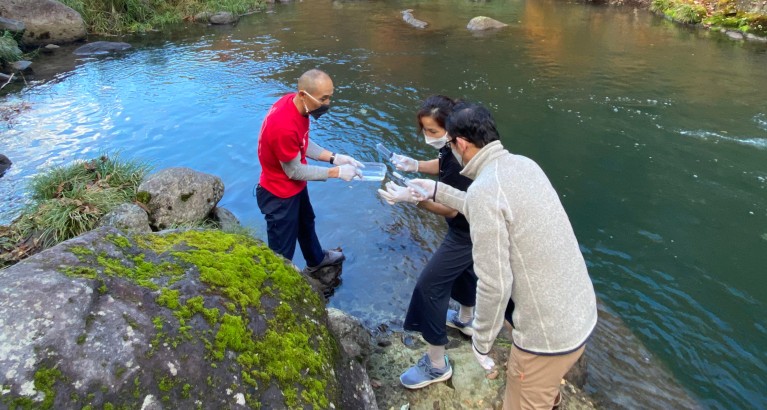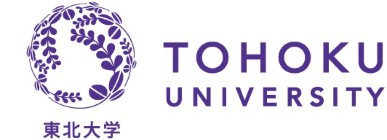A Japanese network is using a new technology to monitor aquatic biodiversity using environmental DNA (eDNA) — the tiny fragments of DNA that organisms shed.
“Traditional ecosystem surveys relied on capturing species and was very labourintensive and less accurate,” explains Michio Kondoh, who manages the All Nippon eDNA Monitoring Network (ANEMONE), a multistakeholder biodiversity database spearheaded by Tohoku University since 2019. ANEMONE became the first database of its kind to be made free and publicly-accessible in June 2022.
“Monitoring eDNA is a powerful method that allows us to see into an ecosystem and understand its components and changes, from just a cupful of water or a spoonful of soil,” Kondoh points out.

Volunteers and researchers from more than two dozen research institutes are gathering data on multiple species from environmental DNA in water.
As part of the project, water samples gathered by volunteers and more than two dozen research institutions in Japan allow for species to be identified and their abundances estimated via eDNA; information that is then combined with other fieldwork data, such as temperature and salinity.
This type of detail is needed to measure the effects of biodiversity initiatives seeking to reverse declines, which was a key data gap flagged during a landmark 2022 UN conference on reversing human-induced biodiversity losses by 2050, Kondoh points out.
It is also required to implement effective company financial disclosure systems, detailing their dependence and the impact of their business activities on biodiversity. These may help to create a flow of funds to nature positive businesses.
NEW CITIZEN SCIENCE
Today, volunteers at nearly 80 fixed monitoring stations and from local communities across Japan contribute to ANEMONE by collecting water samples from oceans, rivers and lakes.
These samples are filtered to detect the DNA of a wide range of species via ‘metabarcoding’ — a technique in which genetic sequences from a specific taxonomic group, called barcodes, are used to make IDs.

Michio Kondoh (at right) manages the All Nippon eDNA Monitoring Network (ANEMONE), a highly detailed multi-university biodiversity database.
The intention is to significantly broaden public contributions to data collection, explains Kondoh, with groups, such as the Japanese branch of the environmental charity Earthwatch, hoping to grow the number of surveys they conduct in Japan from 50 locations in 2022 to 100 in 2023.
A collaboration with Japanese shipping group Kinkai Yusen Kaisha Ltd. has even helped supply samples from the open ocean around Japan.
The accuracy of IDs is improving all the time, Kondoh adds. For example, his team at Tohoku’s Department of Ecological Developmental Adaptability Life Sciences have recently created a bioinformatical tool, Claident, which enables a more accurate identification of organisms from eDNA sequences.
New insights are bound to emerge from the new level of detail being tracked, says Kondoh. In the past, theoretical ecological predictions were almost impossible to fully verify, because measuring species population dynamics is incredibly challenging.
“Now ANEMONE will allow us to monitor multiple species and establish high-resolution visualizations of dynamics,” he says. “The hope is that it might one-day allow us to monitor and predict things that have thus far been mysterious, such as jellyfish blooms, which some think may be the result of climate change.”
SUPPLY-CHAIN FOOTPRINT
At Tohoku University, advanced monitoring technologies are also being developed to track aquatic pollution, which can significantly impact biodiversity.
To monitor mineral use and impact, Kazuyo Matsubae and her team at the Graduate School of Environmental Studies are developing tools to uncover where minerals come from, and where they go. Matsubae is particularly interested in the minerals used in the fast-growing renewables market.

The pollution paths of minerals have been mapped by Kazuyo Matsubae (pictured) and her team at the Graduate School of Environmental Studies.
“The technology needed for a low-carbon society has lifted demand for materials, such as nickel and copper for energy devices, and nitrogen and phosphorus for agriculture,” she explains. “However, we don’t have clear measures of their impact, including the water consumption and pollution from the point of extraction to the time they become waste. We need to know what happens to the whole supply chain.”
Her team has developed a method to measure the environmental disturbances caused by agricultural and industrial activities, such as land use change, water use, and phosphorous and nitrogen emissions, across supply chains. Data is gathered from a range of sources, including satellite imagery. AI also combs through databases, including commodity transaction and mining waste records, Matsubae explains.
The research draws on interdisciplinary collaborations, including those with fishery scientists at Tohoku’s Graduate School of Agriculture, who use satellite images to monitor the coastal environment, identifying seaweed and algae.
This technology could be key to monitoring for dangerous levels of phosphorous and nitrogen pollution from fertilisers and waste water, says Matsubae — levels that could potentially pass a tipping point that would trigger permanent and unsafe environmental changes, leading to plunging aquatic oxygen levels and runaway algal blooms.



 Nature Index Japan 2023
Nature Index Japan 2023